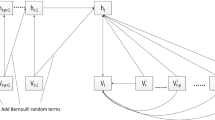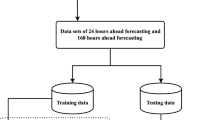Abstract
Algae bloom outbreak is a dynamic nonlinear process with time-varying characteristics and it is difficult for existing algal bloom prediction method to consider the complex characteristics, which leads to low accuracy prediction. For the problem, a dynamic deep belief nets model that combines time series analysis with deep learning methods is proposed by analyzing algal bloom outbreak mechanism. The model introduces historical moment in input layer, increases connection between input layer and hidden layer, uses contrastive divergence algorithm to introduce historical moment in hidden layer and weight and bias algorithms are given timing characteristic in pre-training stage. At the same time, the model adopts dynamic learning rate to complete pre-training and the back-propagation algorithm is used to fine tune network parameters to complete the whole model training. The instance validation results show that the method can more accurately describe dynamic nonlinear process than other prediction methods and further improve prediction accuracy.







Similar content being viewed by others
References
Kitahara, K., Hasegawa, H., Mae, M.: Influence of eutrophication on arsenic speciation in lake waters. Gynecol. Oncol. 56(1), 45–52 (2015)
Wang, X., Yao, J., Shi, Y.: Research on hybrid mechanism modeling of algal bloom formation in urban lakes and reservoirs. Ecol. Model. 332, 67–73 (2016)
Schmidhuber, J.: Deep learning in neural networks: an overview. Neural Netw. 61, 85–117 (2015)
Charalampous, K., Gasteratos, A.: On-line deep learning method for action recognition. Pattern Anal. Appl. 19(2), 337–354 (2016)
Chen, J., Jin, Q., Chao, J.: Design of deep belief networks for short-term prediction of drought index using data in the Huaihe river basin. Math. Probl. Eng. 2012(2), 243–253 (2012)
Yu, D., Deng, L., Dahl, G.E.: Roles of pre-training and fine-tuning in context-dependent DBN-HMMs for real-world speech recognition. In: Proceedings of Nips Workshop on Deep Learning & Unsupervised Feature Learning, (2010)
Zhao, Z., Jiao, L., Zhao, J.: Discriminant deep belief network for high-resolution SAR image classification. Pattern Recogn. 61, 686–701 (2017)
Chen, L.P., Wang, E.Y., Dai, L.R.: Deep belief network based speaker information extraction method. Pattern Recog. Artif. Intell. 26(12), 1089–1095 (2013)
Yao, J., Jiping, X., Wang, X.: Research on algal bloom prediction based on deep learning. Comput. Appl. Chem. 32(10), 1265–1268 (2015)
Zhou, F.Y., Yin, J.Q., Yang, Y.: Online recognition of human actions based on temporal deep belief neural network. Acta Autom. Sin. 42(7), 1030–1039 (2016)
Koesdwiady, A., Soua, R., Karray, F.: Improving traffic flow prediction with weather information in connected cars: a deep learning approach. IEEE Trans. Veh. Technol. 65(12), 9508–9517 (2016)
Qiao, J., Pan, G., Han, H.: Design and application of continuous deep belief network. Acta Autom. Sin. 41(12), 2138–2146 (2015)
Tian, Y.: The application of improved deep belief network in surface roughness of grinding. Modul. Mach. Tool Autom. Manuf. Tech. 07, 108–110 (2016)
Chen, H., Murray, A.F.: Continuous restricted Boltzmann machine with an implementable training algorithm. IEE Proc. Vis. Image Signal Process. 150(3), 153–158 (2003)
Taylor, G.W., Hinton, G.E., Roweis, S.: Modeling human motion using binary latent variables. Int Conf. Neural Inf. Process. Syst. 19(5), 1345–1352 (2006)
Abtahi, F., Fasel, I.: Deep belief nets as function approximators for reinforcement learning. AAAI Conf. Lifelong Learn. AAAI Press 5(1), 2–7 (2011)
Acknowledgements
This work was financially supported by National Natural Science Foundation of China (51179002), National Natural Science Foundation of China (61703008), Major Project of Beijing Municipal Education Commission science and technology development plans (KZ201510011011), and Major Project of Beijing Municipal Education Commission science and technology development plans (KZ201410011014). Those supports are gratefully acknowledged.
Author information
Authors and Affiliations
Corresponding author
Rights and permissions
About this article
Cite this article
Wang, L., Zhang, T., Xu, J. et al. An approach of improved dynamic deep belief nets modeling for algae bloom prediction. Cluster Comput 22 (Suppl 5), 11713–11721 (2019). https://doi.org/10.1007/s10586-017-1460-9
Received:
Revised:
Accepted:
Published:
Issue Date:
DOI: https://doi.org/10.1007/s10586-017-1460-9




